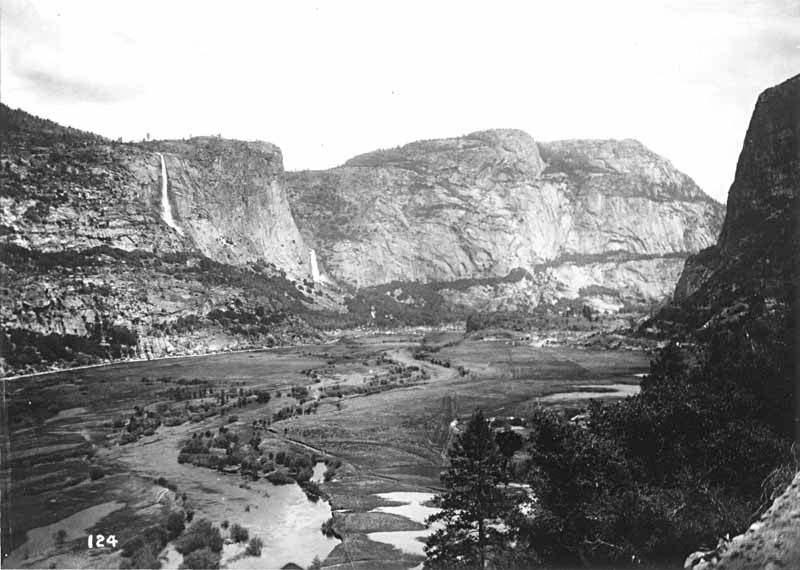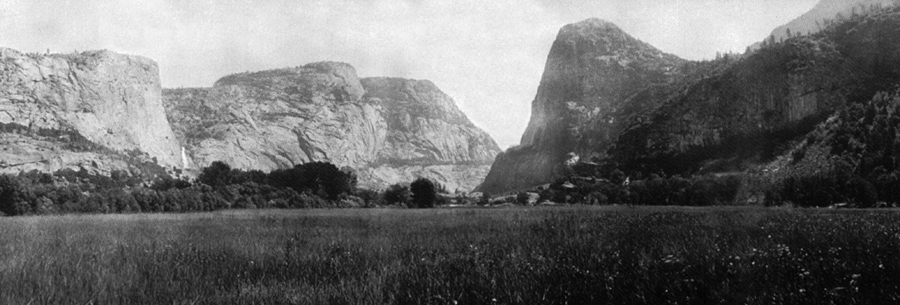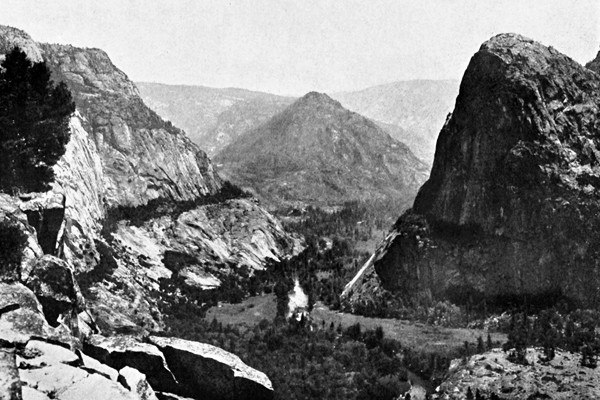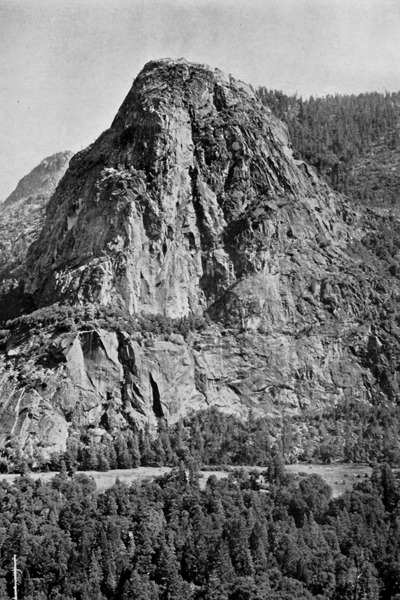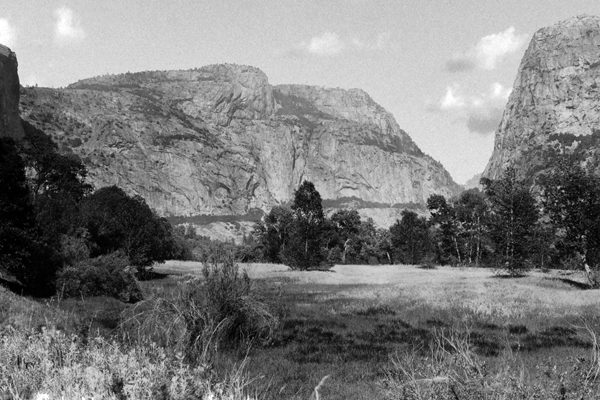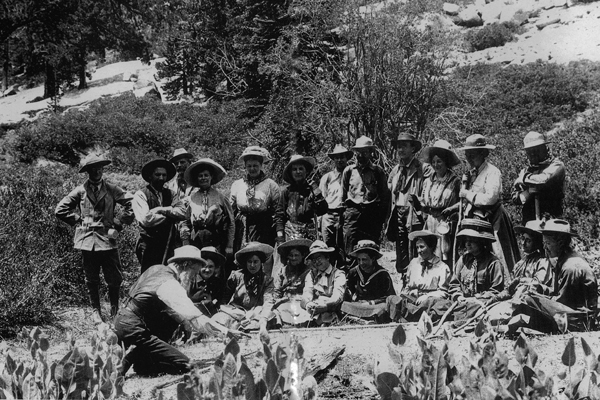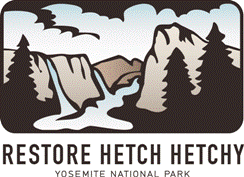This photograph, taken circa 1908, shows the Hetch Hetchy Valley and the Tuolumne River, looking east, as John Muir found it. Wapama Falls is at top left, Kolana Rock on the right. (Photo: Sierra Club Bulletin, Vol. VI. No. 4, January, 1908, pg. 211)Hetch Hetchy: The Resurrection
Formidable political forces are aligned against a movement to restore Yosemite’s Hetch Hetchy Valley, which was destroyed in 1923 with the completion of the O’Shaughnessy Dam. Water from the dam serves some 2.4 million residents of San Francisco and nearby areas, but proponents of restoration insist more viable water resources are closer and more abundant than Hetch Hetchy. A fight that began at the turn of the century continues.
By David McGee
On July 12, 1913 the New York Times published the first of six editorials (PDF) that would appear in its pages that year, all protesting a plan put forth a decade earlier, but only then gaining steam, to "invade" (in the Times's words) Yosemite National Park and destroy the natural wonder known as Hetch Hetchy Valley in Yosemite National Park--our country's first national park--in order to supply the city of San Francisco with drinking water. The Times rightly saw through this deceit by "grabbers of water and power," whom it charged with suppressing a report by a pair of engineers who determined that the Mokelumne River, a source closer to San Francisco than Hetch Hetchy (which is 142 miles away), offered water of better quality and in more abundance than Hetch Hetchy's. "San Francisco's present water supply can be more than doubled by adding to present nearby sources, and more economically than by going to the Sierras," said the Times of these engineers' findings.
The Times's initial broadside against this plan was headlined "A National Park Threatened." Less than five months later, on December 5, a final editorial appeared, "One National Park Lost" (PDF), in the wake of Congressional approval of the Hetch Hetchy dam project. In scathing terms the Times took umbrage at the corrupting influence of money and "a very competent and plausible lobbyist" in Washington. Owing to the underfunded and under-enthusiastic efforts of the dam's opponents, money and connections prevailed, and they paved paradise and put in a dam, to paraphrase Joni Mitchell.
"For this first invasion of the cherished national parks the people of the country at large are themselves to blame," the Times scolded. "The battle was lost by supine indifference, weakness, and lack of funds. All conservation causes in this country are wretchedly supported financially, and this one seems not to have been supported at all.
"Ever since the business of nation-making began, it has been the unwritten law of conquest that people who are too lazy, too indolent, or too parsimonious to defend their heritages will lose them to the hosts that know how to fight and to finance campaigns. The American people have been whipped in the Hetch Hetchy fight. They had the press and enlightened public opinion and all men of public spirit on their side. The lobbyist was too much for them, although at the end the bill was rapidly losing support. If the people had set up a lobby they might have won."
It all sounds so familiar, doesn't it? Guess what? It's happening again, in a way.
Hetch Hetchy Valley 1911: ‘Imagine yourself in Hetch Hetchy on a sunny day in June, standing waist-deep in grass and flowers (as I have often stood), while the great pines sway dreamily with scarcely perceptible motion.’ –John Muir, from his book The Yosemite (1912) (Photo: Library of Congress)At stake this time is the restoration of the original Hetch Hetchy Valley, which John Muir described in his 1912 book The Yosemite as "far from being a plain, common, rock-bound meadow, as many who have not seen it seem to suppose, is a grand landscape garden, one of Nature's rarest and most precious mountain temples. As in Yosemite, the sublime rocks of its walls seem to glow with life, whether leaning back in repose or standing erect in thoughtful attitudes, giving welcome to storms and calms alike, their brows in the sky, their feet set in the groves and gay flowery meadows, while birds, bees, and butterflies help the river and waterfalls to stir all the air into music--things frail and fleeting and types of permanence meeting here and blending, just as they do in Yosemite, to draw her lovers into close and confiding communion with her."
The Times has not forgotten its long-ago anti-dam advocacy. On February 16, 2012, in "Hetch Hetchy's Past and Future," an online editorial, and in the February 17 print edition, the Times reports that Dan Lungren, a Republican Representative from California, has called for Secretary of the Interior Ken Salazar, to investigate whether San Francisco is acting in accordance with the 1913 deal and using all its local water sources before tapping the Hetch Hetchy supply. The "deal" in question allows San Francisco to buy the water for $30,000 a year.
Hetch Hetchy: Yosemite’s Lost Valley from Restore Hetch Hetchy.org (Part 1)
Hetch Hetchy: Yosemite’s Lost Valley from Restore Hetch Hetchy.org (Part 2)
Harrison Ford’s PSA on behalf of Hetch Hetchy"Mr. Lungren, who comes from a district that borders Yosemite, argues that the city is ignoring three vital resources--water recycling, groundwater and harvesting rainwater," the Times notes. "He points out that San Francisco recycles no water at all, and is still paying bargain-basement prices. These measures will not be enough to replace the water San Francisco draws from Hetch Hetchy. But they will help, and, as Mr. Lungren and others have long pointed out, the waters from the Tuolumne River that now feed Hetch Hetchy could be allowed to flow farther downstream to other reservoirs that now serve the San Francisco Bay area."
"Mr. Salazar should look into the matter," the Times concluded in its February 17 editorial. "The issue is not only how San Francisco uses its water but whether there's any rationale, a century later, for the dam and the deal. Ninety-nine years ago, this newspaper argued against the construction of the dam. We lost, but the much bigger loss was nature's."
Now a movement begun more than a decade ago, Restore Hetch Hetchy, is gaining momentum in its efforts to return the valley to the spiritual haven it was in John Muir’s time. The RHH website offers a thorough explanation of the plan to restore the Valley to its original state, the benefits thereof, how to get involved and various other ways to show support for the cause. A complete restoration plan (PDF), published in 2006, is available as an online pdf at the State of California's Resources Agency website.
Leading the opposition to Hetch Hetch restoration: Sen. Dianne FeinsteinNeedless to say, the opponents of Hetch Hetchy restoration have been out in force, for years, much as they were in the early 20th Century.
Former Secretary of the Interior (1985-89) Don Hodel recalled in a 2005 op-ed that his mid-‘80s proposal to remove the dam and restore the valley had been "met by an unexpected firestorm of opposition from some people who normally favored environmental responsibility and conservation, most notably then-mayor of San Francisco, Dianne Feinstein.” In 2007, Rep. Lungren endorsed a proposal in President George W. Bush's 2008 budget to allocate $7 million for an Interior Department study of the feasibility of restoring the valley. "The idea didn't get anywhere," Rep. Lungren says. "I got the strongest impression it was stonewalled by the strongest powers in the House."
Principal among those “strongest powers in the House” is minority leader Nancy Pelosi, but the more vocal opponent is California Senator (and former San Francisco Mayor) Dianne Feinstein (both San Franciscans), who believes the status quo should be maintained.
"The suggestion that San Francisco is not using its water supply efficiently is simply not true," Sen. Feinstein said in a statement published in the Los Angeles Times, December 13, 2011. "Per person, Bay Area residents use less than half ... the state's per-capita average."
Feinstein added, "Hetch Hetchy provides critical water supplies to 2.5 million people and thousands of businesses, and any effort to jeopardize that water supply is simply unacceptable."
Sen. Feinstein, chairwoman of a subcommittee that funded the Interior Department, cited the abovementioned Department of Water Resources study in defending her opposition to the restoration, homing in on its estimate of a $10 billion cost for restoring the valley, including compensation for lost power generation along the system of dams and reservoirs between the valley and San Francisco. "Draining the reservoir would be far too expensive and leave the state vulnerable to both drought and blackouts," she said.
John Muir and Yosemite, from the video California: A TributeRestore Hetch Hetchy.org's response to Sen. Feinstein's claims (from its website section The Plan): So if we take the water out of Hetch Hetchy, do we lose the water that San Francisco needs to survive and prosper? No. San Francisco and other Bay Area communities will continue to receive a reliable supply of high-quality water from the Tuolumne River after Hetch Hetchy Reservoir is drained and the valley returned to the trusteeship of Yosemite National Park. Here's how that can easily be achieved.
Hetch Hetchy is only one of nine reservoirs that comprise the San Francisco Public Utility Commission's water system. Although Hetch Hetchy Reservoir is the most well known, it stores less than 25% of the system's water. San Francisco's water-bank in Don Pedro Reservoir, downstream on the Tuolumne River, holds twice as much water as Hetch Hetchy.
View up Hetch Hetchy Valley, past Kolana Rock, from the south side near the Lake Eleanor trail. (Photo: Herbert W Gleason, Sierra Club Bulletin, Vol VIII, No 3, Jan 1912, plate XLIX)In response to the Feb. 16 Times editorial, Art Torres, a former California state senator who is currently vice president of the San Francisco Public Utilities Commission, sided with the opponents of Hetch Hetch restoration in a letter to the editor in which he claimed, in part: The reliable water and hydroelectric power provided by the Hetch Hetchy system serve the needs of 2.6 million people in 30 Bay Area cities. This system has allowed places like Silicon Valley, the technological capital of the world, to thrive, with the world benefiting from the resulting innovation.
I see firsthand how wisely our ratepayers use water. We’re also investing in the use of recycled water, groundwater, rainwater and graywater. By June, more than six million gallons a day of recycled water will complement the 40 million gallons a day of groundwater used.
But these measures alone won’t be enough to replace the 117 billion gallons of water stored at Hetch Hetchy. And contrary to your editorial, the system’s other downstream reservoirs can’t store this water either. The combined capacity of all the remaining drinking-water reservoirs in the system adds up to only 66 percent of the total storage in Hetch Hetchy.
The Times has not rebutted any of Mr. Torres’s claims, but TheBluegrassSpecial.com reached out to Restore Hetch Hetch.org’s Policy Director Spreck Rosekrans (who also works for the Environmental Defense Fund) for a response.
***
'The Valley Would Be Spectacular Almost Right Away'
Spreck Rosekrans on the Restoration of Hetch Hetchy
Spreck Rosekrans has worked for the past 20 years as a senior analyst with the Environmental Defense Fund. Since 1988, he has worked to find long-term, economically viable solutions that will protect and restore the aquatic ecosystems in California and the West. Spreck has played a lead role helping Restore Hetch Hetchy develop alternatives that would assure a reliable supply of high quality Tuolumne River water is still available to San Francisco and the Bay Area when the valley is restored. (Bio posted at Restore Hetch Hetchy.org)
In a letter to the editor of the New York Times, Art Torres, vice president of the San Francisco Public Utilities Commission, aggressively rebuts a previous Times editorial in support of the restoration of Hetch Hetchy Valley, using a number of figures to support his claim that San Francisco simply cannot do without the Hetch Hetchy water. Your reaction?
Spreck Rosekrans: We met with Art Torres a couple of months ago; our executive director Mike Marshall knows him pretty well and thought that he was sympathetic to our views. But he’s been convinced to go after us here. I’ve been on the Restore Hetch Hetchy board for over ten years, but I just quit the board to join the staff. I’m mostly what passes for a water systems engineer in the environmental world. I did a big report on this for the Environmental Defense Fund in 2004 and I’m pretty technically savvy with the numbers. We’re very serious about making the water system work for San Francisco and the Bay Area, because we know that’s essential for restoration.
About Art Torres’s letter, its first two paragraphs are all true. San Francisco uses about a third of the water that comes to the Bay Area from the Tuolumne River and the Hetch Hetchy Project. San Francisco controls the Project and sells two-thirds of the water to other cities in the Bay Area—Palo Alto, Heyward and a bunch of others—and so when [Torres] says “our ratepayers use the water,” he’s referring to the other parts of the Bay Area that they sell water to, not San Francisco. San Francisco, which controls the system, recycles no water. San Francisco's customers do use some groundwater but less than the 40 million gallons per day that he asserts.
Then the fourth paragraph, he says, “the combined capacity of all the remaining drinking-water reservoirs in the system adds up to only 66 percent of the total storage in Hetch Hetchy.” So what he’s saying here is Hetch Hetchy is most of their storage. Hetch Hetchy is really only about 25 percent of their storage. They own the Cherry and Eleanor Reservoirs, also inside Yosemite National Park--Cherry’s just outside it—and then they have a water bank in the Don Pedro Reservoir that’s about twice the size of Hetch Hetchy. And they don’t physically divert from those other reservoirs; they physically divert from reservoirs in the Bay Area and from Hetch Hetchy Reservoir. But having water in those other reservoirs allows them to divert water that would otherwise belong to the agricultural users that also depend on the Tuolumne River. I know that’s a mouthful, but Hetch Hetchy really is a quarter of their water storage, and he’s mincing words when he says it’s their drinking water. That is physically where they get their water from; but Hetch Hetch amounts to a quarter of the water they store that makes the system reliable, and the other reservoirs are three or four times average annual supply.
Kolana Rock from the valley floor (Photo by Herbert W Gleason, Sierra Club Bulletin, Vol VII. No 4, June 1910, plate LXXXVII): ‘The most strikingly picturesque rock in Hetch Hetchy Valley is a majestic pyramid, over 2,000 feet in height which is called by the Indians 'Kolana.’ It is the outermost of a group like the Cathedral Rocks of Yosemite, and occupies the same relative position on the south wall." --John Muir, testimony to House Committee on Public Lands, 1908How would San Francisco replace the Hetch Hetchy water if valley restoration were approved?
SR: They would continue to rely on their other surface reservoirs. They would divert the river when it’s slowing. They would divert from Cherry Reservoir during dry times of the year. Right now they don’t divert from Cherry Reservoir. And if they go into a multi-year drought and would miss the storage from Hetch Hetchy, the best option is to develop and recharge ground water in wet years from which they would draw in dry years. Most big urban districts don’t actually take the groundwater but exchange groundwater for surface water with ag areas. So they would, for instance, pay San Joaquin Valley irrigation districts to recharge their depleted aquifers in wet years, and then pay them to take that water out in dry years so San Francisco and the Bay Area could rely more on surface water. It’s basically moving the surface storage to the depleted aquifers. There are some in the east side of the San Joaquin Valley, and in some of the outlying parts of the Bay Area, but they don’t actually have water to put back in them. It’s a matter of cooperation between one institution and another institution, and many of these institutions just don’t do a very good job of working together. They do a much better job of it in southern California.
How long has the Restore Hetch Hetchy organization been around?
SR: We founded it in ’99. Ron Good was the head of the Hetch Hetchy restoration task for the Sierra Club--and Sierra Club has periodically voted for restoration but they weren’t pursuing it in any active sense. Ron asked David Brower, the long-time Sierra Club president, what he should do. Brower said, “You may need to form your own group,” and told him to meet with some other folks, including me. I’d done some work on hydrology and reservoir removal, that kind of stuff, for the Sierra Club before. So we formed a group in 1999 and then hired Ron Good, our founder, as our first executive director, and he was executive director until maybe 2008 or so, then he resigned and Mike Marshall took over. Mike’s a political guy who knows San Francisco well, has run ballot initiatives and is more strategic in going about how to really get something done against pretty stiff opposition.
One of the dismaying parts of the story concerns the imposing forces lined up against restoration, namely Senators Pelosi and Feinstein. The latter in particular has made some fairly inflammatory comments. Does it seem like you’re gaining any traction at all when such powerful politicians are opposing you?
SR: I think absolutely we’re gaining traction. Feinstein was Mayor when Don Hodel proposed restoration in ’87 or ’88. She was taken by surprise, she flew up to the dam, declared it to be the birthright of San Franciscans, said it was the worst idea since selling arms to the Ayatollah. I’m a Californian, she’s been my Senator for a long time. I have a lot of respect for her but we do not agree on ever issue--certainly not this one. She’s really dug in on keeping a reservoir in Yosemite National Park, sorry to say. She’s one of the big reasons we’re going on the ballot in San Francisco, because if the citizens of San Francisco say they’re open to restoration and they want to know how much it costs, what the alternatives are and how they can make it happen. We don’t think an elected official will stand in the way.
Hetch Hetchy Valley, 1912: ‘The valley below the spur [of Kolana Rock] is a large open meadow, a mile in length and from an eighth to half a mile in width, with excellent grass, timbered only along the edge.’ --Josiah Whitney, Geological Survey of California, 1871She did make a point of saying the cost of restoration is totally unreasonable. Was she jiggering the numbers there? Ten billion dollars is a daunting figure.
SR: Well, we think the total cost, which is replacing water, power and operating costs, restoration costs, and doing it all for fifty years, is in the two to three billion dollar range. The State of California came out with an estimate that says up to $10 billion dollars. The Environmental Defense Fund, with support of an independent engineering firm, submitted testimony to the California legislature in 2006 which was sharply critical of the cost. Among other things they had facilities that would replace the water supply three to four times over, and they also used some costs for water treatment that are higher than any other agency has ever paid, along with some other problems. That cost estimate has been a real bugaboo for us ever since. We need to get more independent engineers to look at it and get that information out. No one’s ever paid that much for water, and it’s a fairly small amount of water compared to the other big water battles in California—the Bay-Delta Restoration, the Trinity River Restoration, Mono Lake Restoration--these efforts have gone forward, and this is a much smaller amount of water but it gets more attention because it’s a well-known dam; it’s not just putting water back in the environment, it’s actually taking out a dam. For the wrong reasons it’s been labeled as more controversial and more unthinkable from some perspectives than it really should be. In the last twenty years we've developed at least fifteen and probably twenty, twenty-five times the amount of storage we’re talking about here. It’s a matter of doing so in a way that works for San Francisco and the Bay Area.
What about the strength of the restoration effort now as compared to what was reported in the press in 1913, when the dam proposal won Congressional approval? Back then, the New York Times, which opposed the building of the dam, reported that the dam's proponents had won by dint of having more money and a well connected lobbyist on the ground in DC pushing the project, whereas the dam's opponents were not only ill-funded but also failed to muster much public enthusiasm for their cause. Is the Hetch Hetchry Restoration effort better fortified now--politically, financially, and, shall we say, spiritually--to make a stronger case for itself?
As far as how well fortified we are now, politically we are getting there but it is tricky because of Feinstein’s long shadow; financially we are using very limited resources but have huge amounts of pro bono resources; spiritually is not a problem.
If things were to change and you got the go-ahead to restore Hetch Hetchy, how long would the whole process take?
SR: It would take a few years to drain the valley. There’s not a lot of sediments because it’s high Sierra, clear water. The Park Service did a report that said in a few years the bushes and hedges would come back and the river would be in its original course. You’d have as many people there to see it, of course, as you would ever want to get in there, but you’d still have the scars on the walls for many decades. It would be our grandchildren's lifetimes before you’d have a mature forest. But the valley would be spectacular almost right away, and it would be the kind of thing you’d go back to with your children, your grandchildren, and see it all happen; come back five years later and see a little more progress. There’s no question it would be a tremendous asset and inspire people around the world to do similar things in their countries and in their neighborhoods.
***
News Update: Hetch Hetchy Ballot Initiative filed on February 29, 2012
On February 29, Restore Hetch Hetchy.org filed a ballot initiative, “The Water Sustainability & Environmental Restoration Planning Act of 2012.” The initiative, an ordinance, not a charter amendment, “requires San Francisco to develop a long-term plan to modernize its 19th century water system and repair some of the damage done to the environment over the last 100 years.”
It will require 9,702 valid signatures to be gathered by July 9, 2012; a plan to be completed by November 2015, and then brought back to voters for approval as a charter amendment in November 2016. The cost of the planning process is estimated at $8 million.
The initiative maintains the Tuolumne River as the principal source of water supply for San Francisco and its Bay Area customers; identifies the potential and cost of developing local water supplies such as groundwater and recycling; increases supply reliability by identifying additional storage and supply, both within the Bay Area and beyond; improves water quality by filtering all supplies; offsets any loss of hydropower with investments in renewable energy such as wind and solar; decreases polluting wastewater runoff into San Francisco Bay; improves the health of the lower Tuolumne River; and returns control of Hetch Hetchy Valley in Yosemite National Park to the National Park Service.
The initiative does not mandate any particular action--it merely creates a plan for subsequent consideration by voters, and does not affect San Francisco’s water rights on the Tuolumne River.
***
John Muir with a Sierra Club outing on the trail to Hetch Hetchy, 1909 (Photo by George R King, [c] Muir-Hanna Trust, the John Muir Papers, University of the Pacific Library): ‘Restoration would not only re-open the magnificent Hetch Hetchy Valley, but help reduce the chronic overcrowding that plagues its Yosemite Valley neighbor. A fitting tribute to John Muir would be for us to find the wisdom and the will to restore the grandeur of Hetch Hetchy Valley, in the early 21st century, for our families and all future generations.’ --Larry Fahn, Sierra Club President, 2004In the end, the words of John Muir, published in 1912 in his book The Yosemite, in the heat of the dam conroversy, are the strongest argument yet put forth in support of the Hetch Hetchy restoration. Fully cognizant of the forces lined up to demolish the Valley--and, he claimed, the "people's parks" as a whole--and irritated by the thoughtless behavior of park visitors bent on spoiling the natural beauty of the valley in their own fashion, Muir spared no one in defending the sanctity of Hetch Hetchy but reserved special enmity for the political and financial forces steamrolling the dam's opponents. "The proponents of the dam scheme," Muir thundered, "bring forward a lot of bad arguments to prove that the only righteous thing to do with the people's parks is to destroy them bit by bit as they are able. Their arguments are curiously like those of the devil, devised for the destruction of the first garden--so much of the very best Eden fruit going to waste; so much of the best Tuolumne water and Tuolumne scenery going to waste. Few of their statements are even partly true, and all are misleading." A poet in a naturalist's body, John Muir's spiritual cry on behalf of the holy temple he believed nature had constructed in Hetch Hetchy remains aloft in the winds of Yosemite. Listen, and you can hear.
To contribute to the Restore Hetch Hetchy campaign, follow this link to the Network for Good
Founder/Publisher/Editor: David McGee
Contributing Editors: Billy Altman, Laura Fissinger, Christopher Hill, Derk Richardson
Logo Design: John Mendelsohn (www.johnmendelsohn.com)
Website Design: Kieran McGee (www.kieranmcgee.com)
Staff Photographers: Audrey Harrod (Louisville, KY; www.flickr.com/audreyharrod), Alicia Zappier (New York)
E-mail: thebluegrassspecial@gmail.com
Mailing Address: David McGee, 201 W. 85 St.—5B, New York, NY 10024


